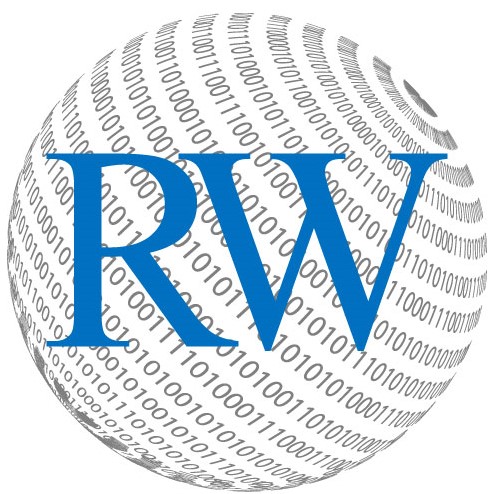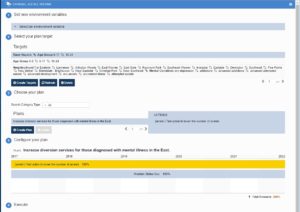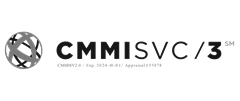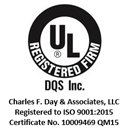Reference World (RW) is an Agent Based Modeling and Simulation application that allows for the true complexities of life to be incorporated and maintained in the simulation and is the best choice for simulating a system composed of entities whose behaviors are complex and non-linear. It consists of a “deterministic” model built from as much or as little data as the user deems appropriate, with a simulation engine that powers agents of different types and functions to interact in ways that replicate societal functions. The agents themselves contain “decision” and “learning” algorithms so they act in ways that replicate what they represent.
Deterministic (deductive logic[1]) modeling tools deliver results which are based on extrapolation of historical data and events. Deterministic models commonly use decision trees with branch coefficients to create the model. One of the benefits of this approach is that you always get the exact same output from the exact same input because all the relationships are defined. You can put your finger on a diagram and trace the numbers backward to the initial change for a sense of causality. Adjustments are made to the model to refine and match real-world outcomes by adjusting coefficients so that the model agrees with what the latest results turned out to be – essentially to what just happened. This is a good predictor assuming the significance of previously ignored factors or elements change.
This approach fundamentally creates a backward-looking model that constrains the modeling and simulation of forward-looking problems to a backward-looking orientation. This model is limited in its abilities and can only do what was built into it. A model of this type requires continual involvement and upkeep, working with disparate data sources to continually update forced-choice coefficients to the latest historical events.
A well-known example of a complex deterministic model which was made famous by the Elisabeth Bumiller article of the New York Times titled “We Have Met the Enemy and He is PowerPoint”[2] which focused a deterministic model on causality and the complexity of the American strategy in Afghanistan in early 2010. This model uses thirteen factors with arrays of elements to diagram flows and strengths of relationships of elements. This approach derives statistically significant elements and correlations from historical data and ignores all else. It is like having a “sandbox” of data and everything that happens in the future must fall within the boundary of that historical sandbox.
Figure 1. A “Causal Loop” diagram based on a decision tree methodology
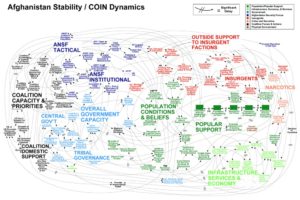
 Deductive/Deterministic models rely on historical (known) information and relationships
Deductive/Deterministic models rely on historical (known) information and relationships
Our approach goes further. We have the state-of-the-art analytic toolkit to extract the deterministic model from the data, then we layer our agent-based simulation engine over it to generate deterministic and emergent outcomes that include and apply inductive logic[3].
With Reference World we apply complex theory and mathematics to build fractal-like representations of people, organizations, institutions, and, overlay communications networks all on representations of the applicable geography. Reference World™ eliminates the need of trying to determine which variables and factors to include and exclude from the model, and escape data set boundaries that limit outputs in multivariate regression models and decision trees. The “future” emerging from the simulation doesn’t have to fall into the same “sandbox” data set as the past. Emergent phenomenon – new outcomes, play out in the simulations. New variables, new pathways, and new correlations can emerge. We integrate deductive and inductive logic into a single platform to forecast more realistic futures.
How can Reference World add value to your organization?
Reference World can escape the forced-choice paradigm of a deterministic model by incorporating emergent phenomenon that traditionally cannot be factored into a simulation. Reference World provides a simulation engine that is continuously online and up-to-date, shared, supported, validated, and an unbiased synthetic representation of the real world at varying granularities.
Reference World™ provides access to customer-supplied and open source data integrated in a seamless manner with a continuously updated world model. The accuracy and value of the Reference World™ community of knowledge rapidly increases over time as users incorporate their own data and models which result in increased accuracy and scope of new simulation experiments. Additionally, automated web-mining tools can continually search for new open-source data to fill in gaps and keep content up-to-date.
Figure 2. The Simulation Engine powers agent interactions and captures results
Click on the Figure to see an animation of the RW Simulation in action
How does Reference World Work?
By combining millions of artificial agents representing organizations and institutions, with a statistically valid sample of the population as “human” agents, RW creates a comprehensive, realistic, and quantitatively and qualitatively representation of the real world. RW enables users to dramatically improve decision-making, anticipate and shape the future, and explore alternative explanations for political, economic, social, and information influences of communities, nations, corporations, and transnational actors.
Table 1. What Reference World does and what you gain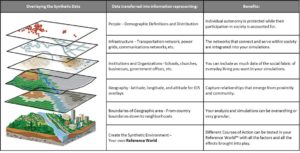
The Anatomy of an Agent
Reference World represents each virtual community using five primitive constructs: Individuals, Organizations, Institutions, Infrastructures, and Geographies (IOIIG). These five constructs are used to model the emerging higher order constructs such as:
- Geographical Entities (Nations, Provinces, Cities)
- Political systems (Type of government, political parties/factions)
- Military (Soldiers, Institutions)
- Economic System (Formal and Informal)
- Social System (Organizations & Groups)
- Information Systems (Print, Broadcast, Internet, Social Networks)
- Critical Infrastructure (Banking, Oil & Gas, Electricity, Telecommunications, and Transportation)
To represent a synthetic world, individual agents are constructed as a proportional representation of the societal makeup of the real world. Each agent is encoded with static traits such as gender, nationalism, ethnicity, race, income, education, and religion as well as dynamic traits such as their political, societal, and well-being. In this way, agents in the RW are made to be culturally specific, holding opinions towards other entities and reacting to their perception of their needs. Agents also have “memories,” enabling individuals to respond based on previous simulation interactions.
Figure 3. A simulation engine within each agent activates the agent characteristics and actions.
Algorithms that stochastically replicate variations and similarities of agent actions and responses are part of the internal simulation engine within each agent.
An agent’s well-being consists of nine fundamental needs:
- Basic
- Political
- Financial
- Security
- Religious
- Social
- Educational
- Health
- Freedom of Movement
Both traits and well-being determine the basic goals for an agent and when the environment is changed within RW, the agents sense the changes and reacts accordingly to its “DNA.”
An individual agent can be an ordinary citizen or leader. A citizen represents the general population and are focused on personal benefit. A leader agent acts as a citizen, but is also is encoded with influence levels that reflect his/her power within the group, organization, or institution. Leader agents can affect the political and social climate of their environment and impose their views upon citizens and organizations to promote their respective goals. The goal of a leader agent is to set the agenda of the organization in which they reside and persuade the citizen/member agents to make decisions that favor their agenda.
Figure 4. Agents are incorporated into the synthetic environment built from data
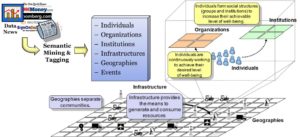 You can define the richness of the synthetic environment through your data sets
You can define the richness of the synthetic environment through your data sets
Clusters of citizen agents form larger entities such as groups, organizations, and institutions. Groups are either Formal or Informal. Rules of Engagement for Formal Groups are published and relatively static, while those of Informal Groups are only known to its members and continuously evolved with interactions to the environment.
Institutions are modeled as “governmental entities” such as the Military, Law Enforcement, Court System, Executive, and Political Parties. These entities have discretionary resources and can formulate legally binding policies. Government Institutional agents represent the leadership and various branches of government. Institutions have the power to influence the behaviors of members and non-members.
The Synthetic Economy
The synthetic economy consists of fifteen sector agents which are identified in the figure below.
Figure 5. Social Infrastructure and Sectors can be brought into the simulation engine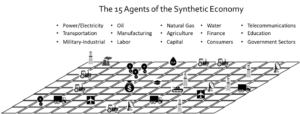 You can have as much or as little economic granularity as you want and the data allows.
You can have as much or as little economic granularity as you want and the data allows.
Reference World provides a mechanism to explore the micro-foundations of macro-level phenomena. Once consumers, governments, and business infrastructure agents begin to stimulate demand within a synthetic economy, the production sectors begin to produce output. Economic agents within a synthetic economy engage in international trade if they cannot satisfy their demand and sell all their supply domestically. International trade patterns change as domestic and international conditions fluctuate, and macro-level variables (such as GDP) emerge from micro-behavior while also influencing the latter in an iterative process.
The Synthetic Geography within RW captures the relationships that emerge from proximity and community. The Synthetic Geography includes latitude, longitude, and altitude for GIS overlays. With Synthetic Geography, boundaries can range from the national level, down to specific neighborhoods allowing your analysis and simulations to be overarching or very specific, depending on the granularity of the data you’re using.
With a rich Synthetic Geography, RW provides a real-time geographic view as a needs analysis and testing environment for solving complex problems with limited resources for the geographic area of interest.
Emergent Interactions Among Agents
Intricate relationships between agents emerge within the RW. Emergence is used to explain phenomena where macro behaviors arise from the interaction of multiple, localized, autonomous, and diverse behaviors. However, an emergent pattern such as the behavior of heterogeneous societies, cannot be simplified down to a sum of the behaviors of individuals within a society. We avoid trivializing issues found within the behavior of a society that comes from constructing an aggregated model of its constituent parts using a systems dynamics approach without allowing outliers to exist.
Furthermore, the constituent makeup of a society is dynamic over time as constituents join our leave the society. A representation of society is not a closed system. External influences, such as real-world injected data, changes the environment and can influence the behavior of the society’s constituents, and thereby impact the behaviors of the society.
In RW the behavior of a group emerges as agents. Autonomous IOIIG agents evolve through interacting with their dynamic environment and the activity of other agents such as interactions in its social network, organizations joined, political organizations the agent supports or opposes, leaders the agent has an affinity towards, media subscriptions, local events, and economic trends that influence the agent’s well-being.
How do Users interact with Reference World?
Users play different roles within the RW environment allowing them to choose different actions for key individuals in the scenario and analyze the impact and outcomes of those actions. Because RW agents are designed to interact independently with their environment and other agents, multiple users can play any number of roles within a simulation, creating an interactive “gaming” environment. Users view the current state of the system, predict the actions of other agents, take into consideration the dynamics of the environment, and choose among the actions available to the role. Each action can be taken at different intensities and is taken by agents for one or more nodes within the simulation, including other individuals and infrastructure. Once the actions are selected for each role, the simulation is played out for a pre-defined period.
Automated Agents and Human-In-The-Loop Technology
The agents in RW consist of both artificial agents as well as accommodating human agents. Artificial agents can include persons such as leaders, citizens, soldiers, etc. that are known to function in the real-world environment. A human agent can represent any agent of any type in the simulation and insert their actions and reactions into the simulation through the agent they play. This represents what is described as human-in-the-loop capability.
The RW artificial agent consists of goals, traits, actions, behaviors, and sensors. Different algorithms are embedded into each agent to simulate decision-making ability. These algorithms, depending on their nature and sophistication, enable:
- Adaption by relating desired and un-desired events to cause and effect
- Course of Action (COA) selection, sequencing, and timing
- Sensing to determine effects and what sensory indicators to look for and when
- Measuring and comparing effectiveness of COAs
- Self-regulation through calculating the degree of success of a COA and determining if changes need to be made
The behavior of human agents is not predetermined, and people can actively participate within the simulation as an agent in specified roles. The human-in-the-loop agent playing in the simulation is free to act within the capabilities and constraints imposed by the parameters of the unique experiment.
Setting Up Your Simulation
You can define the different policies and strategies, including specific actions and the timing of the actions that make up the policy or strategy based on various models extrapolated from the data sets and brought into the simulation engine.
Figure 7. You can build the actions to be included in a Policy and their timing.
You can select actions and their timing to test the policy and its useful life.
During, or upon completion of the simulation, users can use visualization tools to analyze the simulation. Based on their analysis, users can leverage saved and/or shared action playbooks from other users to develop additional action plans. These new action plans can then be submitted for further execution, providing an incremental planning environment. At the completion of the simulation, further analysis can be conducted to explore the correlations and causality of events, helping users to better understand the potential impacts of their actions and decisions in the real world.
Simulation Outputs Can Be Shown In Various Ways
Map visualizations provide a snapshot of data aggregated by geographies. The RW interface can be configured to display any statistics that are tracked within the system. This allows users to quickly gain a high-level perspective of important statistics throughout the regions of interest. By animating the simulation through time, users can quickly and easily identify and analyze changes as different actions take effect.
Figure 8. Visualizations in different maps and styles are available.
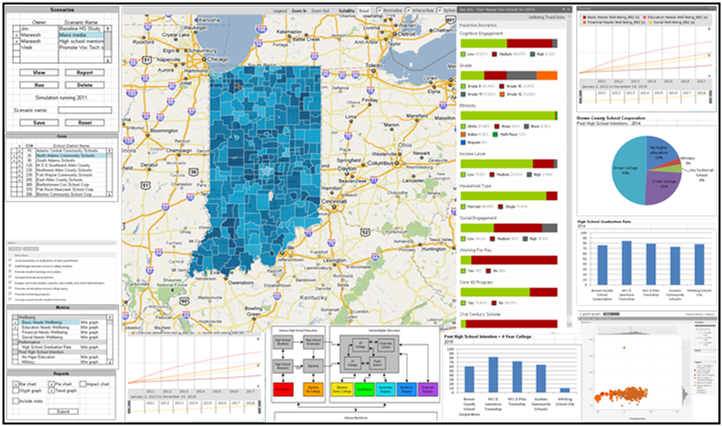
You can visualize in ways that changes data into information.
Many other tools are available and can be customized to analyze trends, states of data, and simulation outcomes, such as the DNA chart which displays trends of a multitude of statistics in one location. Through color mapping, a user can see if a statistic has increased or decreased over a specified timeframe. Correlations among data can be made visually by viewing how different statistics increase and decrease over time.
Figure 9. RW can provide time series analysis and views.

You can look at changes over time.
Compare Results of Different Policies and Strategies
With Reference World, you can run multiple, parallel simulations and perform a comparison of Key Metrics of various CoAs, providing decision makers with a broad and deep understanding of likely outcomes and the information necessary to take actions that lead to the desired outcome.
Figure 10. Selection of tailored views of simulation outcomes
You can tailor the view and which simulation results you want to compare.
Your World in a Box
Reference World is a mature, scalable, and highly sophisticated Agent Based simulation and multi-sided gaming platform with the ability to scale from neighborhoods, to international systems. Reference World can model individuals, communities, cities, counties, provinces, states, nations, regions, and the world in terms of political, military, economic, social, information, and infrastructure systems in an integrated manner.
Figure 11. Reference World brings it all to you in the ways you need it.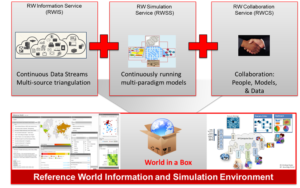 You decide how much of the world you need in your RW platform to serve your full set of needs.
You decide how much of the world you need in your RW platform to serve your full set of needs.
Reference World provides a continuously online, up-to-date, shared, supported, validated and unbiased synthetic representation of your world. Reference World overlays knowledge mined from real-world data on a synthetic representation to truly represent your World in a Box. Reference World provides highly reliable and actionable information that allows decision makers to assess policies, allocate resources, define new pathways for success, and identify gaps and shortfalls that inhibit achievement of your goals.
Reference World provides maximum
“Decision Power Today for a More Confident Tomorrow.”
To learn more about Reference World and learn how we can help you create your synthetic world, please contact us at info@cfday.net or call us at 571-402-1220.
[1] Deductive Logic is applying a theory to an observation such as “historically 40 % of people have done X so multiply the number of people we observe now by 40% to see how many do X now.”
[2] Bumiller, E. (2010, April 26). We Have Met the Enemy and He Is PowerPoint. The New York Times. Retrieved from http://www.nytimes.com
[3] Inductive Logic is making observations of the world then constructing a hypothesis to explain the observations i.e. “before, 40 % of people did X and 60% did Y, now 50% do X or Y and 50% do Z. Hypothesis: Z is replacing X and Y.”


